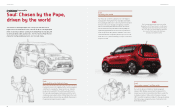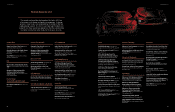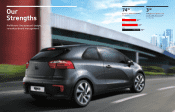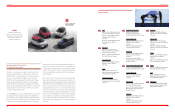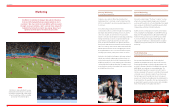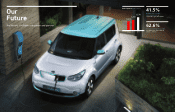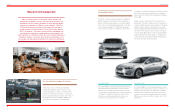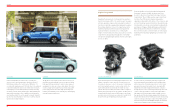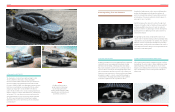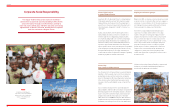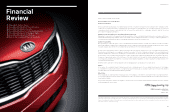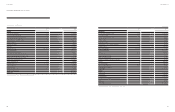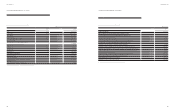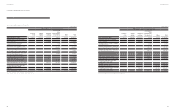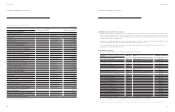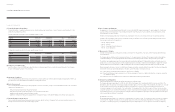Kia 2014 Annual Report Download - page 27
Download and view the complete annual report
Please find page 27 of the 2014 Kia annual report below. You can navigate through the pages in the report by either clicking on the pages listed below, or by using the keyword search tool below to find specific information within the annual report.
Engines for growth
Regarding the development of next-generation powertrains,
Kia Motors will replace 70% of its current lineup of ten engines
with next-generation engines, while increasing the number of
transmissions and turbo-equipped diesel and gasoline engines.
This will allow Kia Motors to boost its competitiveness in the
market by improving fuel efciency and securing powerful
engine performance. Kia will also focus on reducing the
weight of its key models and continuously secure fuel economy
competitiveness by expanding the application of ultra-high-
strength steel and lightweight materials (from the current 20%
level to over 50%).
3. Soul EV
Launched in April 2014, the Soul EV is an eco-friendly, zero-
emissions electric car powered by an 81.4 kW motor and a 27
kWh lithium-ion battery. The Soul EV reaches 100 km/h in 11.2
seconds, and its maximum speed is 145 km/h. Due to the optimized
regenerative braking ratio and new air conditioning technologies,
its driving range is a class-leading 148 km per charge (veried by
the Ministry of Trade, Industry and Energy). Its driving stability was
improved by lowering the center of gravity, and its body stiffness
was strengthened by 27% over the regular Soul model. Using 23.9
kg of biomass-based materials for its interior, Soul EV has obtained
UL Environmental Claim Validation.
4. Ray EV
The Ray EV is Korea’s rst mass-produced electric vehicle. It is a
mini CUV powered by a 50 kW electric motor with a 16.4 kWh
high-capacity lithium-ion battery. Its wheels feature improved
aerodynamics to reduce air resistance while driving. The vehicle
includes a regular-speed charger that can charge using a 220V
power supply as well as an exclusive high-speed charger port.
Its battery has a durability of more than 10 years, eliminating any
worry about battery replacement.
Every year, Kia Motors hosts the Hyundai-Kia International
Powertrain Conference. In 2014, the theme was “From
Evolution to Revolution: Powertrain Technologies for Future
Clean Mobility”. Over 1,100 powertrain experts and ofcials
from more than 150 relevant companies and academic
organizations attended the 14th edition of the conference, and
a total of 56 seminars were held. Kia Motors drew attention by
introducing the economical, environmentally friendly and high
performance V3 Kappa 1.0 turbo GDI engine and the Nu 2.0
HEV 6-speed automatic transmission with electric oil pumps.
These conferences allow us to demonstrate our technological
leadership in the industry by highlighting our innovative new
powertrains.
1. Engine downsizing
Engine downsizing involves decreasing engine displacement or the
number of cylinders in order to raise fuel economy. However, as
the engine size decreases, so does its horsepower. A turbocharger
assists in increasing the amount of compressed air sent into the
engine which adds horsepower despite the smaller size. Kia’s
gasoline direct injection (GDI) system further enhances engine air
intake by directly injecting fuel into the cylinders. The GDI system is
installed in all Kia vehicles, while the T-GDI engine, in which turbo
and direct injection technologies are combined, is found in the K3
(Cerato/Forte) Koup, K5 (Optima) and Sportage models.
2. Clean diesel
In order to reduce air contaminants emitted by our vehicles, Kia
Motors developed a Common Rail Direct Injection (CRDi) engine
which increases fuel efciency by using electronic control to inject
appropriate fuel amounts as needed. We also developed a VGT
(Variable Geometry Turbocharger) which minimizes combustion
through the precise control of exhaust gas ow passage. As a result
of these technologies, Kia Motors’ diesel vehicles realize 20% to
30% higher fuel efciency and about 20% fewer CO2 emissions
than gasoline cars. Our diesel engine-equipped vehicle lineup now
includes the K3 (Cerato/Forte), Pride (Rio) and Soul models. Currently,
our diesel car lineup is switching to engines with LLP-EGR and LNT-
related technologies in line with EURO-6 standards, the latest diesel
engine emission legislation from the European Commission.
50 51
Annual Report 2014Our Future


